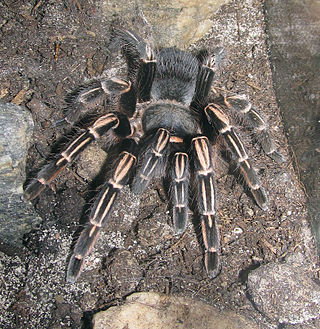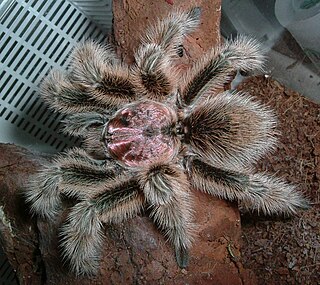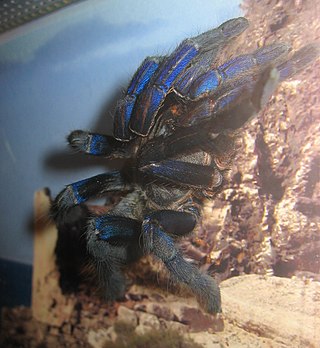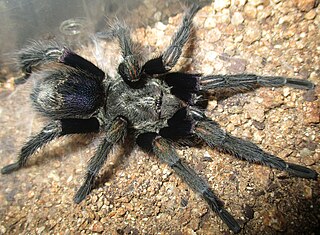
Avicularia is a genus of the family Theraphosidae containing various species of arboreal tarantulas. The genus is native to Panama, the Caribbean, and tropical South America. Each species in the genus has very distinguishable pink foot pads.

Aphonopelma is a genus of tarantulas native to the Americas. It includes nearly all the North American tarantula species north of Mexico and a considerable percentage of the tarantula species that range into Central America. Most are fairly large tarantulas with leg spans of 6 in (16 cm) or more. Like most New World tarantulas, all species of Aphonopelma have urticating hairs. Despite their fearsome appearance, these tarantulas are not harmful to humans and some species are popular in the pet trade. With about 90 species described so far, Aphonopelma comprises about 10% of the total number of described tarantula species. However, their taxonomy is poorly understood and species are difficult to tell apart, especially those that are brown or black without other pattern. Therefore, the actual number of species is unknown, with more species likely to be identified in the near future. In captivity, they are usually fed crickets; in the wild, they eat most insects, including crickets, grasshoppers, cockroaches, mantises, and beetles.

Grammostola is a genus of South American tarantulas that was first described in text by Eugène Louis Simon in 1892. These medium- to large-sized spiders are native to tropical South America, and are usually brown in color, with pinkish or orangish-red hairs. The very docile Chilean rose tarantula is popular as a beginner's spider among tarantula enthusiasts.

Ornithoctoninae is a subfamily of tarantulas found in Southeast Asia. It was first erected in 1895 by Reginald Innes Pocock based on the type specimen Ornithoctonus andersoni.

Selenocosmia is a genus of tarantulas that was first described by Anton Ausserer in 1871. The genus is found in China, New Guinea, Australia, Indonesia, Myanmar, Malaysia, Laos, Vietnam, Philippines, India and Pakistan. They are commonly referred to as whistling or barking spiders, due to their ability to stridulate using lyra hairs.

Euathlus is a genus of South American tarantulas that was first described by Anton Ausserer in 1875. These spiders are medium sized and are usually found in high elevations in the Andes. It is a senior synonym of Paraphysa, and was formerly considered a senior synonym of Brachypelma, but this was later rejected.

Phormictopus is a genus of spiders in the family Theraphosidae (tarantulas) that occurs in the West Indies, mainly Cuba and Hispaniola, with three species probably misplaced in this genus found in Brazil and Argentina.

Tarantulas comprise a group of large and often hairy spiders of the family Theraphosidae. As of December 2023, 1,100 species have been identified, with 166 genera. The term "tarantula" is usually used to describe members of the family Theraphosidae, although many other members of the same infraorder (Mygalomorphae) are commonly referred to as "tarantulas" or "false tarantulas". Some of the more common species have become popular in the exotic pet trade. Many New World species kept as pets have setae known as urticating hairs that can cause irritation to the skin, and in extreme cases, cause damage to the eyes.
Cyclosternum is a genus of tarantulas that was first described by Anton Ausserer in 1871.

Cyriopagopus is a genus of southeast Asian tarantulas found from Myanmar to the Philippines. As of March 2017, the genus includes species formerly placed in Haplopelma. It was first described by Eugène Louis Simon in 1887.

Acanthoscurria is a genus of tarantulas that was first described by Anton Ausserer in 1871. They are found throughout South America including the countries of Argentina, Bolivia, Brazil, Ecuador, French Guiana, Guyana, Paraguay, Peru, Suriname and Venezuela, plus into the Windward Islands West Indies,.

Sericopelma is a genus of tarantula, found in Central America from Nicaragua to Panama. The limits of the genus and its distribution have long been confused; it is closely related to the genus Aphonopelma. Sericopelma species are among the largest found in Central America. They can be kept as pets, although at least one species has been described as "very aggressive".

Lasiodora is a genus of tarantulas that was first described by Ludwig Carl Christian Koch in 1850. They are often very large; body lengths of up to 25 centimetres (9.8 in), including the legs, are not unusual.

Ischnocolus is a genus of tarantulas that was first described by Anton Ausserer in 1871. This tarantula genus includes some of the smallest in the family.

Holothele is a genus of tarantulas that was first described by Ferdinand Anton Franz Karsch in 1879. Originally placed with the curtain-web spiders, it was transferred to the tarantulas in 1980.

Nemesia is a genus of mygalomorph spiders in the family Nemesiidae, first described by Jean Victoire Audouin in 1826.















